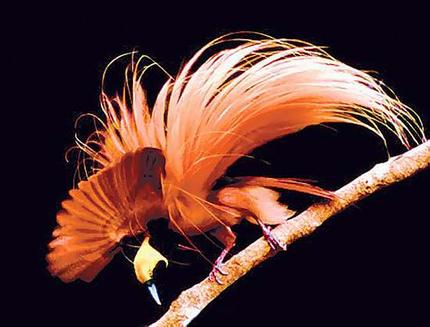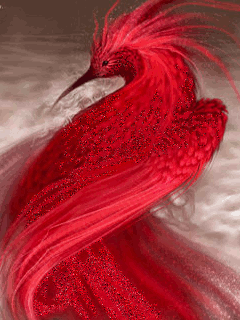|
BIRD OF PARADISE >> Love of Truth with its Intelligence >> Conjugial Love
 The most charming of the beautiful birds is the bird of paradise. There are several species quite unlike one another in the disposition of their charms, yet all eminent for the combined grace and richness of their plumage. The emerald bird of paradise is thus described: The most charming of the beautiful birds is the bird of paradise. There are several species quite unlike one another in the disposition of their charms, yet all eminent for the combined grace and richness of their plumage. The emerald bird of paradise is thus described:
The general color of the upper part of the body is rich chocolate brown, the whole of the front being covered with velvet-like feathers of the deepest green, at one moment sinking into black, and at another flashing forth with glittering emerald. The upper part of the throat is bright golden green, and the upper part of the neck a delicate yellow. The most wonderful part of this bird’s plumage is the mass of loose floating plumes that rises from the flanks, and extends in a most graceful manner far beyond the tail. Even in the absolute quiet of a stuffed skin under a glass case, these plumes are full of an astonishing beauty, their translucent golden white vanelets producing a most superb effect as they cross and recross each other, forming every imaginable shade of white, gold, and orange, and then deepening towards their extremities into a soft, purplish red. There is a magnificently arranged specimen of this bird in the British Museum, placed in a separate case, and worthy of a separate journey merely for that one object.
But when the bird is living and healthy, no pen can describe the varied and changeful beauties that develop themselves at every moment; for the creature seems to comprehend within its own single form the united beauties of all other members of the feathered tribe.
Mr. Bennett describes the habits of an emerald bird of paradise in captivity. He says:
One of the best opportunities of seeing this splendid bird in all its beauty of actions, as well as display of plumage, is early in the morning, when he makes his toilet; the beautiful subalar plumage is then thrown out and cleared from any spot that may sully its purity, by being passed gently through the bill; the short chocolate colored wings are extended to the utmost, and he keeps them in a steady, flapping motion, as if in imitation of their use in flight, at the same time raising up the delicate long feathers over the back, which are spread in a chaste and elegant manner, floating like films in the air. In this position the bird would remain for a short time, seemingly proud of its heavenly beauty, and in raptures of delight with its most enchanting self; it will then assume various attitudes, so as to regard its plumage in every direction.”
The bird took a bath regularly twice a day; but except for the bath would not descend to the bottom of its cage, for fear of soiling its feathers. So proud is the creature of its elegant dress, that it never permits a soil to remain upon it, and it may frequently be seen spreading out its wings and feathers, and regarding its splendid self in every direction, to observe whether the whole of its plumage is in an unsullied condition.
 He was much pleased with the reflection of himself in a mirror, regarding it kindly as another beautiful bird, but without the slightest envy. If he has no envy, I think it follows that he is not vain; and, indeed, the whole description seems to show that he considers himself charged with the delightful duty of preserving in good order, and presenting always to the best advantage the exquisite beauties entrusted to him. He evidently corresponds to a love for presenting spiritual truth in all its gracefulness and goodness in order that it may be loved and lived. ( Bennett’s Wanderings, quoted in Wood’s Natural History. ) He was much pleased with the reflection of himself in a mirror, regarding it kindly as another beautiful bird, but without the slightest envy. If he has no envy, I think it follows that he is not vain; and, indeed, the whole description seems to show that he considers himself charged with the delightful duty of preserving in good order, and presenting always to the best advantage the exquisite beauties entrusted to him. He evidently corresponds to a love for presenting spiritual truth in all its gracefulness and goodness in order that it may be loved and lived. ( Bennett’s Wanderings, quoted in Wood’s Natural History. )
Swedenborg remarks:
Some have thought what is spiritual to be like a bird that flies above the air in the ether, where sight does not reach; when yet it is like a bird of paradise that flies near the eye, and touches its pupil with his beautiful wings, and wishes to be seen. (Divine Love and Wisdom #374)
Into the middle windows of the palace which represented the habitations of conjugial love in human minds flew a pair of birds of paradise, which, the angel said, represented the conjugial love of “the love of truth with its intelligence”; that is, they represented the love of perceiving and presenting the beautiful truths of spiritual life, with the intelligent affection which receives them.
The angels of the silver age delight in the study of spiritual truth, and, what is remarkably like the bird of paradise, they love the representation of it in forms and colors. In the visit to them, described in the work Conjugial Love,#76,
Swedenborg relates that a rainbow was presented “upon the wall, consisting of three colors, purple, blue, and white; and we saw how the purple color passed the blue, and tinged the white with an azure color, and that this color flowed back through the blue into the purple, and elevated the purple into a brightness as of flame”; and an angel, explaining, said:
“The purple color, from its correspondence, signifies the conjugial love of the wife, the white color the intelligence of the husband, the blue color the beginning of conjugial love in the husband’s perception from the wife, and the azure color with which the whiteness was tinged, conjugial love then in the husband; this color flowing back through the blue into the purple, and elevating it into a brightness as of flame, signifies the conjugial love of the husband flowing back to the wife.”
This was one of many representations exhibited in that heaven in which the angels delighted. Such delight would be presented in form as noble birds of beautiful plumage, varying in kind according to the wisdom especially loved. Our love of beautiful forms and colors is sometimes from a similar origin. If our taste were quite sincere, that is, if we loved the things which really touch our hearts, and if our hearts were full of affection for spiritual truth and charity, and our perceptions of these things were clear, we should see that our hearts were touched, and consequently that our taste was delighted with the things that correspond to our affections. As it is, our sincerest pleasure in beauty is of this kind, though we perceive the correspondence obscurely or not at all.
Author: JOHN WORCESTER 1875
|
|